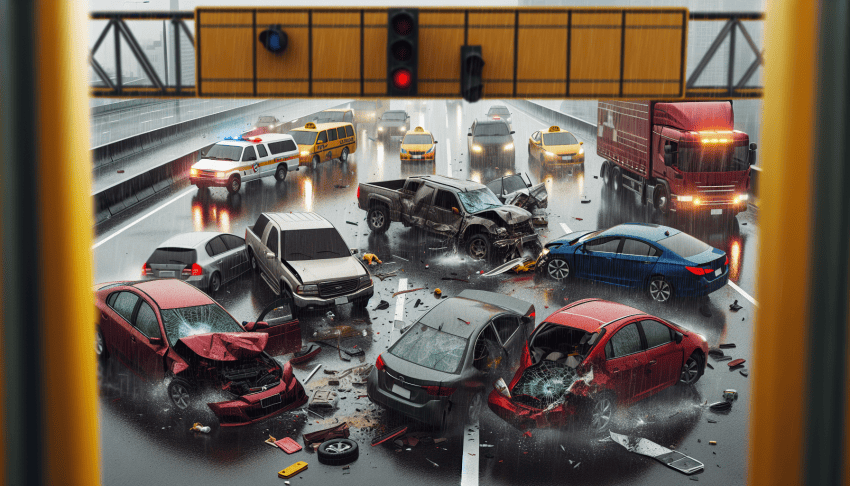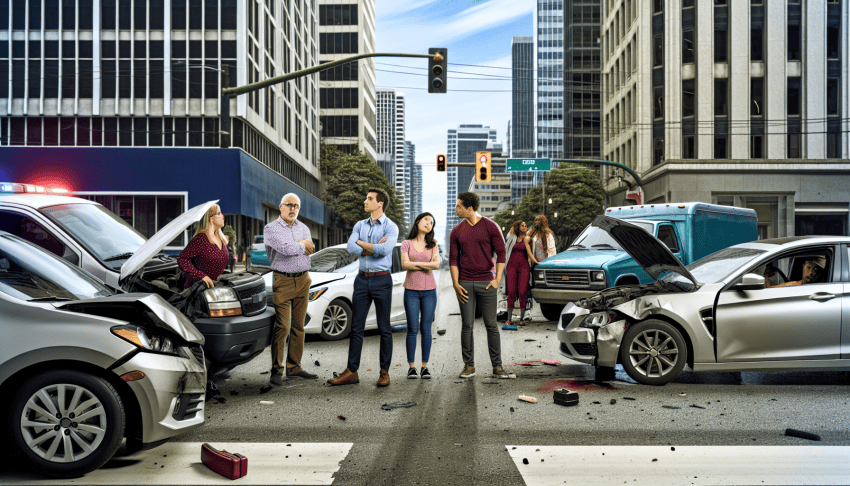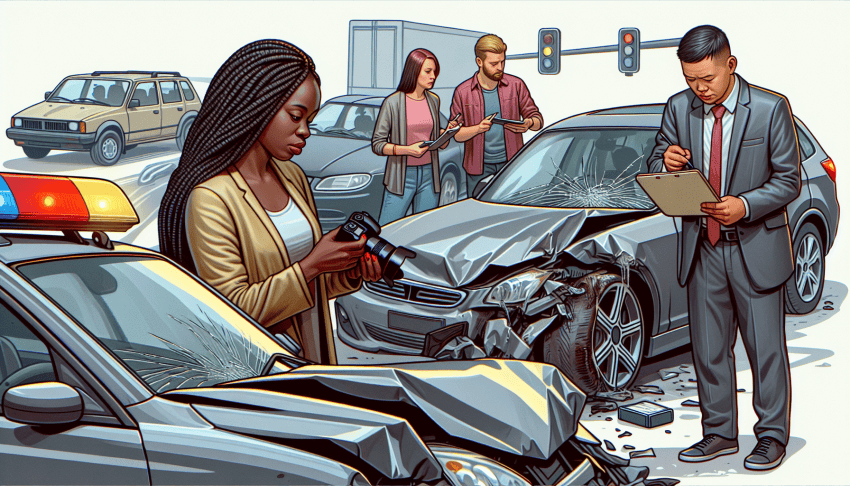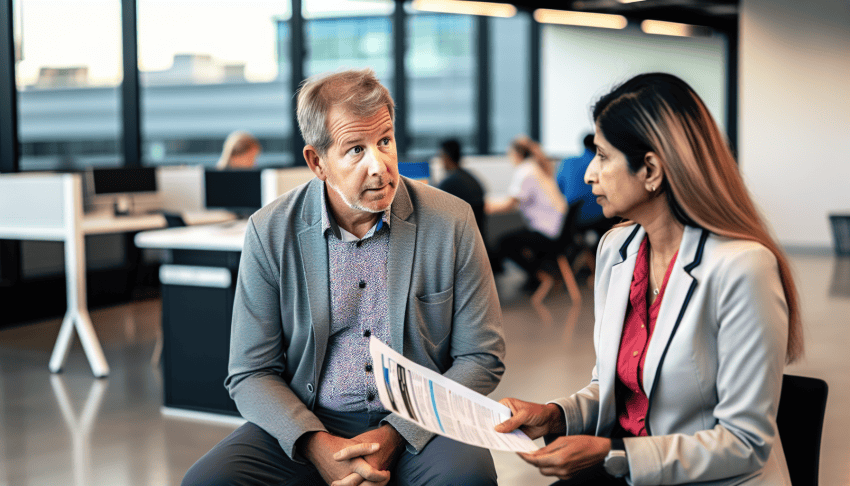4.9 Rating
Google REVIEWS
Leaders in Georgia Personal Injury Law Since 1995
Determining Liability in Chain Reaction Car Accidents: A Comprehensive Guide
When a crash involves not just two cars but several, pinpointing ‘liability in chain reaction car accidents’ becomes a complex issue. If you’re caught up in such an event, you’re likely wondering: who’s at fault, and how will this affect my insurance claims or legal responsibilities? In this comprehensive guide, we’ll dissect the intricate process of determining liability, examine the roles that individual driver actions and roadway conditions play, and outline the legal pathways available to you. Whether you’re seeking compensation or navigating an insurance dispute, this article aims to provide the clarity needed in the aftermath of these multi-vehicle accidents.
Key Takeaways
- Chain reaction car accidents involve multiple vehicles and can be highly complex to resolve, necessitating experienced legal representation to navigate the intricacies of determining fault and negotiating with insurance companies.
- Liability in chain reaction accidents is determined through rigorous investigation and the application of comparative negligence laws, and can be influenced by external factors like weather conditions and road maintenance.
- Victims of chain reaction accidents may seek compensation for damages such as medical expenses and property damage; however, obtaining compensation requires a deep understanding of legal processes and is aided by hiring a skilled attorney.

Understanding Chain Reaction Car Accidents
Chain reaction car accidents are not your typical fender-benders. They are complex incidents involving multiple vehicles, each with its own trajectory and impact. In these accidents, the severity can be influenced by factors such as the speed of the vehicles and the specific circumstances of the collision. Picture a scenario involving three or more vehicles, or in extreme cases, up to 200 cars. Now imagine the challenges of deciphering who hit whom first and who bears the most fault in a chain reaction car crash. These chain reaction car crashes can be incredibly difficult to untangle and assign responsibility.
These accidents are not only a nightmare for the drivers involved but also for the investigators and insurance adjusters who must untangle the web of impacts, causes, and liabilities. The process is often akin to piecing together a complex puzzle where the pieces are constantly moving. Given the potential for severe injuries and substantial property damage, it is essential to consult an experienced car accident lawyer who can:
- Navigate the intricacies of such cases
- Gather evidence and build a strong case
- Negotiate with insurance companies on your behalf
- Represent you in court, if necessary
By hiring a car accident lawyer, you can ensure that your rights are protected and that you receive the compensation you deserve.
Definition and Dynamics of Chain Reaction Accidents
A chain reaction car accident, often referred to as a ‘pile-up’, is a series of cascading collisions that occur when one vehicle’s impact leads to one or more subsequent crashes. Picture a congested highway during rush hour or under severe weather conditions. One driver brakes suddenly, catching the driver behind off guard. This driver crashes into the first car, and before you know it, multiple vehicles are involved, each collision triggering the next.
The dynamics of such accidents are as complex as the definition suggests. The driver who caused the initial collision is generally considered the at-fault party, but fault may also be distributed among several drivers based on their actions or negligence. Determining liability becomes more complicated with the increasing number of vehicles involved, as factors like speed, braking, and traffic conditions come into play to establish the cause of the initial impact.
Common Causes and Contributing Factors
What triggers a chain reaction car accident? The answer, like the accident itself, can be multifaceted. Some common causes include:
- Reckless or aggressive driving, such as tailgating or speeding
- Distracted driving, like texting or eating while driving
- Sudden vehicle malfunction
- Driving under the influence
These factors can often lead to rear-end collisions, which then initiate chain reaction collisions.
External conditions also play a significant role. Poorly maintained roads, for instance, can precipitate these accidents. Similarly, weather conditions such as heavy rainfall, fog, or snow can increase the risk of chain reaction accidents. Regardless of the weather, drivers are expected to adjust their driving accordingly and maintain safe driving habits.
Potential Consequences and Challenges
The consequences of chain reaction accidents are often grave, especially in cases of a chain reaction crash. Victims may suffer from a range of injuries including spinal cord trauma, traumatic brain injuries, and whiplash, which can have long-term debilitating effects. The sheer number of vehicles involved complicates the determination of fault in a chain reaction traffic accident, as each driver potentially contributes to the cause of the incident.
Insurance companies face their own set of challenges. They may struggle to fairly compensate all injured victims due to policy limits that can be exceeded in the event of a chain reaction accident. The complexity of these accidents necessitates a careful and thorough investigation to ascertain fault and determine the appropriate compensation for each party involved.
Legal Aspects of Liability in Chain Reaction Accidents
Beyond the physical and emotional toll, chain reaction accidents also entail a complex web of legal considerations. The intricate nature of these accidents raises questions about negligence, as the actions of one driver can trigger a series of events involving multiple drivers and vehicles. Furthermore, liability in these accidents is not always straightforward, as it may be influenced by a variety of factors such as the actions of the drivers, the nature of the collisions, and even external conditions like weather.
For instance, in Georgia, trailing vehicles in a chain reaction rear-end collision are generally presumed liable for not maintaining a safe distance and failing to react in time. However, determining the liability of a vehicle, whether front, middle, or rearmost, involves assessing its legal positioning, the driver’s efforts to prevent the collision, and any exceptional circumstances that could reduce or eliminate liability.

Negligence and Fault
Negligence in the legal context of a car crash is defined as a driver’s failure to exercise the level of care that a reasonable person would under similar circumstances. This can result in legal liability for the driver. In chain reaction accidents, liability may be shared among multiple drivers. If fault cannot be conclusively determined, insurance companies may assign partial responsibility to all parties involved. Under Georgia law, individuals deemed to be 50% or more at fault in a car accident are barred from recovering compensation, which is why admitting mistakes or fault can have significant legal implications.
Proving negligence in chain reaction accidents is often complicated due to the involvement of several parties and external factors such as road conditions and weather. Therefore, having legal representation is vital for those involved. An experienced car accident lawyer can help navigate these complexities and build a strong case for compensation.
Comparative Negligence and Proportionate Responsibility
The concept of comparative negligence comes into play when multiple parties are involved in a chain reaction accident. This principle allows a claimant to recover damages even if they are partly at fault, with specific laws varying by state. The respective degrees of fault of each party are assessed, and their liability and damages are apportioned accordingly, potentially through separate awards or offsets against each other.
Importantly, the percentage of fault assigned to each party directly affects the amount they owe or can recover in damages. Insurance companies may reduce the compensation amount in proportion to the claimant’s degree of negligence. This makes the process of determining comparative negligence a critical aspect of dealing with chain reaction accidents.
External Factors Influencing Liability
External factors such as bad weather and natural hazards can also impact liability in chain reaction accidents. For example, these conditions can sometimes precipitate accidents without clear fault from any driver. In fact, weather-related crashes account for approximately 21% of all motor vehicle crashes in the United States. Some common weather-related factors that contribute to accidents include:
- Wet pavement
- Rainfall
- Snow and ice
- Fog and reduced visibility
- Strong winds
It is important for driver b and other drivers to be aware of these factors and adjust their driving accordingly to prevent accidents.
Despite these conditions, drivers are expected to maintain safe driving habits. High winds, precipitation, fog, varying pavement temperatures, and water levels can significantly impact road safety and subsequently, accident liability. In Georgia, even when weather conditions contribute to accidents, comparative fault rules will still allocate a percentage of fault to all involved parties.

Investigating and Establishing Fault in Chain Reaction Accidents
Due to their complex nature, chain reaction accidents present substantial challenges in ascertaining fault. The fact-finding process often involves multiple drivers who may be at fault due to various forms of negligence, such as:
- excessive speed
- distracted driving
- failure to maintain a safe distance
- failure to obey traffic signals
Consequently, determining responsibility in these cases can become even more intricate.
Insurance adjusters play a pivotal role in the investigation of such accidents. They conduct their own fact-finding alongside relying on police reports to ascertain liability. Given the potential involvement of multiple parties, consulting an attorney for immediate identification and documentation of all pertinent evidence is crucial.
Documenting the Accident Scene and Damages
Documenting the scene of a chain reaction accident is essential to create a timeline of events, identify the parties involved, and understand their actions. This includes taking photographs of the accident scene, including skid marks and vehicle debris. Such evidence is critical for determining fault and can be especially persuasive in court.
In addition to physical evidence, here are some important procedural steps to follow after a chain reaction accident:
- Exchange insurance information with all drivers involved
- Obtain contact information for witnesses
- Keep detailed records of all communications with insurance companies, including representative names, call times, and conversation summaries
Following these steps is crucial for maintaining a valid and strong claim.
Obtaining Police Reports and Witness Statements
Police reports provide comprehensive details on the chain of events in an accident, which are indispensable in analyzing a chain reaction accident. These reports include diagrams and descriptions that can help to understand the sequence of events and identify the vehicle responsible for initiating the chain reaction.
Eyewitness statements are equally vital. They can contain observations of relevant driving behavior before the crash, contributing to the determination of fault. Together, police reports and eyewitness accounts form key pieces of evidence in proving a driver’s negligence after a chain reaction accident.
A thorough liability assessment in chain reaction accidents relies on the proper interpretation and integration of both these types of evidence.
Utilizing Technological Evidence
In the digital age, technological evidence plays an increasingly important role in determining fault in chain reaction accidents. Event Data Recorders (EDRs) or ‘black boxes’ in vehicles record critical data that is key to assessing impact severity and reconstructing the accident. However, the acquisition and analysis of EDR data require specialized equipment and expertise, and must comply with legal regulations to be admissible in court proceedings.
Dashcam and traffic camera footage provide real-time accounts of the crash, helping to determine the sequence of events and identify the vehicle responsible for initiating the chain reaction. Additionally, GPS and smartphone data can reveal information about a driver’s speed and movement patterns prior to the collision, contributing to the determination of fault or negligence in chain reaction crashes. Expert accident reconstruction specialists utilize this technological evidence to analyze the vehicles’ dynamics and drivers’ actions, which is essential for establishing the direct cause of the accident.
Navigating Insurance Claims and Legal Proceedings
After a chain reaction accident, victims often face a challenging path of navigating insurance claims and legal proceedings. As stated earlier, these accidents involve multiple vehicles, drivers, and insurance companies, making the process complex and stressful. Hiring a personal injury attorney can significantly affect the outcome, providing expertise in legal proceedings and aiming for a fair settlement.
Representing oneself during a personal injury claim is generally not advisable due to the legal complexities involved, especially so in cases of chain reaction accidents. The risks of self-representation increase in personal injury claims where multiple vehicles are involved, necessitating the need for professional legal counsel. Personal injury lawsuits stemming from chain reaction accidents are complex, as they may entail establishing the negligence of multiple drivers.

Dealing with Insurance Companies
In the aftermath of a chain reaction accident, dealing with insurance companies can be a daunting task. Here are some steps to follow:
- Report the accident to your insurance company promptly.
- Provide a clear account of the incident.
- Provide only necessary information to insurance companies and avoid excessive details about the accident or injuries to prevent affecting your claim negatively.
Having legal representation can help you navigate these interactions, ensuring that your interests are safeguarded and that discussions are strategic and professional. An attorney can prevent you from providing too much information to insurance agencies, which could be used to devalue your compensation claim. They can also negotiate with insurance companies and navigate disputes, thus aiming for a fair compensation without unjust penalties.
Seeking Legal Representation
Consulting an attorney at Scholle Law soon after an accident can significantly influence the outcome of your case. Evaluating case options for seeking compensation before the statute of limitations expires is an important aspect to consider. An experienced car accident lawyer should be contacted immediately after an accident to take the appropriate steps for legal rights and compensation interests.
Legal representation is highly recommended in personal injury claims involving chain-reaction collisions due to their complexity. Lawyers have a deep understanding of insurance companies’ tactics and can effectively navigate conversations and negotiations to secure a reasonable settlement. They also help navigate the complexities of proving negligence and comparative fault, vital for obtaining compensation.
Pursuing Compensation for Damages
Victims of chain reaction car accidents can seek compensation for various types of damages, including:
- Medical expenses
- Lost wages
- Property damage
- Pain and suffering
If liability is shared among drivers in a chain reaction accident, the costs for repairs and medical bills may be divided proportionally between the involved insurance companies.
However, pursuing compensation for damages is not a straightforward process. It requires a detailed understanding of laws and regulations, an ability to negotiate with insurance companies, and a comprehensive collection and presentation of evidence. This is where having an experienced car accident lawyer can make a significant difference. They can guide victims through the legal maze and help them secure the compensation they deserve.
Summary
Understanding the dynamics of chain reaction car accidents and their legal implications is crucial, given their complexity and potential for severe outcomes. From determining fault to navigating insurance claims and legal proceedings, every step of dealing with a chain reaction accident is fraught with challenges. Whether you are a driver trying to understand your responsibilities on the road, or a victim seeking justice and compensation, having an experienced car accident lawyer by your side can significantly ease this arduous journey. Remember, when it comes to chain reaction accidents, it’s not just about determining who hit whom first; it’s about unraveling a complex web of events, actions, and responsibilities.
Frequently Asked Questions
Who is at fault in a 3 car rear end collision in Georgia?
Determining fault in a three-car rear-end collision in Georgia involves examining the specific circumstances of the accident. Generally, the driver of the car that initiates the rear-end collision is often found at fault, as drivers are expected to maintain a safe distance from the vehicle in front of them. However, there can be exceptions.
Whose fault is a pileup?
In a pileup, any driver can be at fault, and more than one driver are often held accountable. It’s a complicated situation with many variables.
Who is responsible for a chain reaction accident?
The driver who caused the first crash in a chain reaction accident is typically responsible for damages, pending evidence that no other driver shares liability. Always consider all factors when determining responsibility.
How are damages apportioned in a chain reaction accident?
In a chain reaction accident, damages are apportioned based on the assessed degree of fault for each party involved in the accident. This determines their liability and how damages are distributed among them.
What should I do immediately after a chain reaction accident?
After a chain reaction accident, it’s important to document the scene, exchange insurance information, gather witness contacts, and report the incident to your insurance company promptly. Taking these steps can help ensure a smoother resolution.
